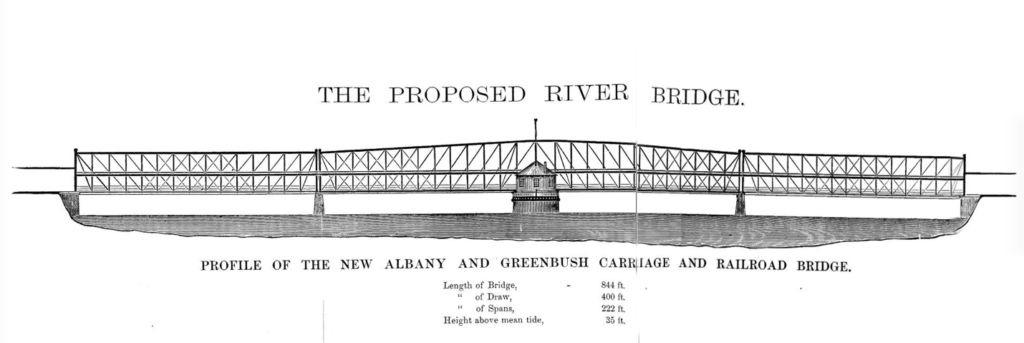
Yesterday we had an artist’s rendering from 1886 of the then-new Albany Greenbush bridge. It looks like it was built pretty much according to this plan, which was laid out in the charter of the Albany Greenbush Bridge Company, which gave these specifications:
Wrought Iron Bridge.
The company contemplates erecting a bridge of wrought iron for the accommodation of carriages and foot passengers, and over the carriage-way a railroad track. The bridge will be 844 feet long, a 400 feet draw in the center, and a 222 feet span at each end. The following extract from the specifications will show the ease with which the draw is to be managed.
Draw.
The first draw span will be 400 feet long over all, and will be located between the two fixed spans, and will be built on a turntable 36 feet diameter from center to center of drum. The bridge across the Mississippi at Louisiana, Mo., has a draw 444 feet, and has been worked successfully for four years past. This will be of same pattern.
Draw – How Worked.
The draw span will be worked by two steam engines, connected at right angles with suitable machinery to swing draw span wide open in the space of one minute’s time, and close it in the same space of time, and suitable hand gearing to operate draw span in case the engines are disabled.
Spans.
The fixed spans will be two in number, each 222 feet long from center to center of end pins.
Height of Spans.
The height of fixed spans will be 34 feet and 9 inches from center of bottom chord to center of top chord.
Navigation.
This draw is within a few feet of the same length as that of the bridge chartered by Congress and constructed over the Mississippi river at Louisiana, No., and it must be taken into consideration that the Mississippi river at that point has a current of six miles per hour, while there is no perceptible current in the Hudson river. As to obstructing the navigation of the Hudson by this contemplated bridge, those who pretend to believe it do so because they are opposed to any bridge. They know it will not in the least impair the commercial interests of the city of Albany.

Leave a Reply